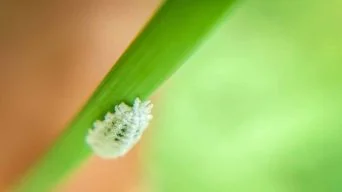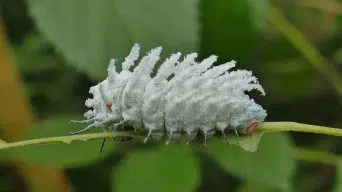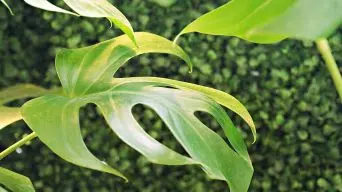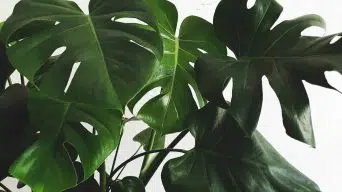Thrips are tiny insects that can damage Monstera plants by causing discoloration on leaves. To get rid of thrips, isolate the plant, create traps, increase humidity, and apply neem oil, insecticides, or pesticides. Propagate surviving leaves and monitor for re-infestation. Act quickly to prevent further damage.
Are you noticing brown spots and yellowing leaves on your Monstera plant?
You might have a thrips infestation.
Thrips are tiny, sap-sucking insects that can cause severe damage to your houseplants.
Fortunately, getting rid of thrips is not as hard as it may seem.
Here we will discuss how to identify and remove thrips from your Monstera plants quickly and easily.
Read on for tips on how to protect your plants from further infestations in the future!
How To Identify Thrips on Monstera Plants
Thrips are tiny, winged insects that can be difficult to spot with the naked eye.
They are usually white or yellow and measure only 1/20 of an inch in length.
While they may not look like much, thrips can cause significant damage to monstera plants if left unchecked.
Physical Characteristics of Thrips
Thrips have two pairs of wings that are fringed with hairs. They have long antennae, and their bodies are slender and elongated.
Depending on the species, they may be white, yellow, brown, or black.
The most common type of trip found on monstera plants is the western flower thrip (Frankliniella occidentalis).
These thrips feed on plant sap and can cause yellowing or browning of leaves and distorted growth patterns.
Signs of Thrips Infestation on Monstera Plants
The most obvious sign of a thrip infestation is discoloration or spots on the leaves.
Look for yellow or brown patches that appear mottled or streaked across the surface.
You may also notice small black spots on the underside of any affected leaves – these are fecal deposits left behind by adult thrips after feeding.
If you look closely enough, you may even be able to spot some adult thrips crawling around your plant’s foliage.
Another telltale sign is distorted growth patterns caused by thrips feeding on new shoots and buds before they have had a chance to open up fully.
This can result in stunted growth or deformed leaves that curl inward at the edges instead of spreading outwards like normal healthy foliage should do.
You may also see silvery streaks along leaf veins, indicating where adult female thrips have laid eggs inside the plant tissue.
How to Differentiate Thrips from Other Pests
It’s important to differentiate between thrips and other pests when identifying an infestation because they require different treatments to eliminate them effectively.
For example, aphids tend to leave behind sticky honeydew secretions. However, spider mites produce webbing along stems and leaf undersides, which can be seen with the naked eye if you look closely enough.
Mealybugs also leave behind white waxy deposits, which can easily be mistaken for thrip fecal matter but will wash off with water. Thrip fecal matter will remain firmly in place no matter how hard you scrub it away!
In addition, many other pests, such as caterpillars or scale insects, feed directly on plant tissue. Thrips prefer to feed off sap, and their damage tends to be more subtle than other types of pest infestations – although it can still cause significant harm if left untreated!
How Thrips Affect Monstera Plants
Thrips can cause severe damage to Monstera plants if left unchecked.
They feed by sucking out the sap from monstera leaves, stems, and flowers.
They use their piercing-sucking mouthparts to puncture plant cells and extract the sap inside.
This causes yellow or brown discoloration on the leaves and black spots on the underside of any affected leaves.
The feeding process also reduces the pressure exerted from inside leaves and root tissues, which can lead to wilting or stunted growth in severely infested plants.
Additionally, thrips excrete honeydew, encouraging sooty mold growth that further damages plant foliage.
In extreme cases, an infestation of thrips may even kill a monstera plant if it is not treated quickly enough.
To prevent this from happening, it is essential to identify an infestation early and take steps to control it before it gets out of hand.
How To Get Rid of Thrips on Monstera Plants
Thrips can be challenging to detect and eradicate due to their small size and fast reproduction rate.
If you suspect your Monstera plant is infested, taking action quickly before the problem gets out of hand is important.
There are several ways to get rid of thrips on Monstera plants.
1. Insecticidal Soap for Controlling Thrips
Insecticidal soap is a great way to kill thrips without harming your Monstera plant.
You can buy a pre-mixed organic insecticidal soap or make your own using 1 teaspoon of mild liquid dish detergent mixed with 1 quart of water.
Shake the bottle well before spraying, and spray a small amount on an inconspicuous part of the plant first to ensure it won’t harm the leaves.
Then spray the entire plant, getting both sides of all leaves and stems.
Repeat this process every few days until you no longer see signs of thrips.
2. Neem Oil for Treating and Preventing Thrips
Neem oil is another effective way to treat and prevent thrips on your Monstera plant.
It disrupts their reproductive cycle, preventing them from laying eggs and reproducing.
To use neem oil, mix 2 teaspoons of neem oil with 1 quart of water in a spray bottle and shake well before spraying it onto your plant.
Cover both sides of all leaves and stems thoroughly, then repeat every few days until you no longer see any signs of thrips.
3. Traps and Sticky Cards for Thrips Management
Sticky traps and cards are also useful tools for controlling thrips populations on your Monstera plant.
Traps work by attracting adult thrips with pheromones or other attractants, while sticky cards trap them when they land on them.
Place traps or sticky cards near infested plants so that adult thrips will be drawn away from them instead of laying eggs in the soil around them.
Replace traps or sticky cards regularly as needed to keep the population under control.
4. Lint Roller Method for Manual Removal of Thrips
The lint roller method is another simple way to manually remove thrips from your Monstera plant without using chemicals or pesticides.
Hold a leaf flat in your palm and gently roll a lint remover over it until all visible thrips have been removed from both sides of the leaf surface.
Repeat this process with all affected leaves until you no longer see any signs of thrips activity on your Monstera plant.
5. Increasing Humidity To Control Thrips Population
Increasing humidity levels around your Monstera plant can also help control its thrip population by making it less hospitable for these pests to thrive in its environment.
Try misting the leaves regularly with water or placing a humidifier nearby to increase humidity levels around your plant’s foliage and discourage thrip activity from occurring there as much as possible.
6. Pruning Infested Leaves And Stems
If you notice that some parts of your Monstera are heavily infested with thrip activity, it may be necessary to prune off those affected areas.
Trimming your Monstera plant helps prevent the further spread throughout the rest of the plant’s foliage or even into other plants nearby if left unchecked for too long.
Pruning off infested leaves or stems will help reduce thrip populations significantly while allowing new growth free from pest activity so you can enjoy healthy foliage again soon enough!
7. Beneficial Insects To Control Thrips Population
Introducing natural predators into your garden, such as ladybugs, lacewings, predatory mites, etc., can help naturally control thrip populations by preying upon them directly without causing any harm towards other beneficial insects or even yourself!
This is especially helpful if you’re looking for an organic solution that doesn’t involve harsh chemicals or pesticides since these beneficial insects will do all the work for you while keeping everything safe!
How To Prevent Thrips on Monstera Plants
Prevention is always the best way to keep your Monstera plants free from thrip infestations.
The following tips can help you keep your Monstera plants looking healthy and thriving while avoiding thrip activity as much as possible:
1. Quarantine New Plants
The first step in preventing thrips from invading your Monstera plant is to quarantine any new plants before introducing them into your collection.
This will help ensure that any pests or diseases present in the new plant don’t spread to the rest of your collection.
When bringing a new plant home, inspect it carefully for signs of infestation and isolate it from other plants until you’re sure it’s pest-free.
2. Clean Monstera Leaves Regularly
Regularly cleaning the leaves of your Monstera plant is another great way to prevent thrips infestations.
Use a damp cloth or soft brush to gently wipe down the leaves, removing any dust or debris that may be harboring pests or eggs.
Be sure to pay special attention to the undersides of the leaves, as this is where thrips tend to congregate.
3. Remove Debris and Fallen Leaves
In addition to regularly cleaning your Monstera’s leaves, remove any fallen leaves or debris from around the base of the plant as soon as possible.
Thrips are attracted to decaying organic matter, so leaving these items around can attract them and increase their chances of infesting your plant.
4. Avoid Overcrowding Plants
When growing multiple plants together, ensure they have enough space between them so air can circulate freely and any pests or diseases don’t spread between plants as quickly.
Overcrowding can increase the chances of infestation and make it harder to spot any signs of pest activity before they get out of control.
5. Use Neem Oil as a Preventive Measure
Neem oil is a natural insecticide that can be used as a preventive measure against thrips infestations on Monstera plants.
It works by disrupting the reproductive cycle of pests and preventing them from laying eggs on your plant’s leaves or stems.
To use neem oil as a preventive measure against thrips, mix 1 teaspoon of neem oil with 1 quart of water in a spray bottle and apply it directly onto your Monstera’s leaves every two weeks during peak season (spring through fall).
Ensure you thoroughly cover both sides of each leaf with the solution for maximum effectiveness.
6. Monitor for Early Signs Of Thrips Infestation
Finally, watch for early signs of thrip infestation, such as yellow spots on leaves or white specks along stems and veins.
These could indicate an active thrip population on your Monstera plant!
If you notice any signs like these, immediately isolate the affected plant and treat it with neem oil or an appropriate insecticide according to package instructions to prevent further spread throughout your collection.
Final Thoughts
When it comes to thrips on Monstera, the best approach is prevention.
Make sure your plants are in a clean environment and inspect them regularly for signs of pests.
If you find an infestation, immediately isolate the plant from other houseplants and treat it.
With regular vigilance and proper care, you can keep your monsteras healthy and free of pests.







